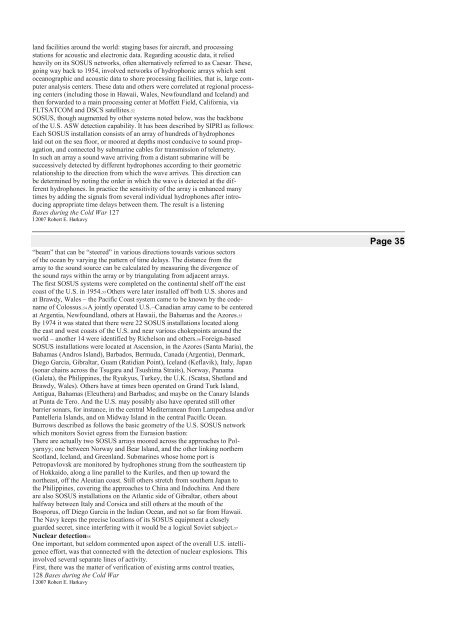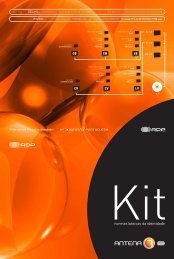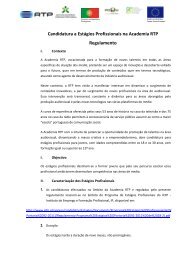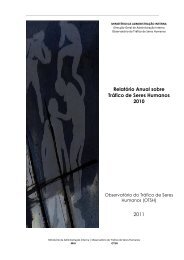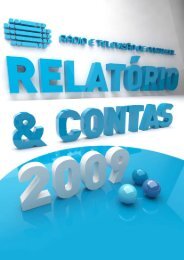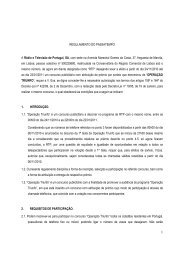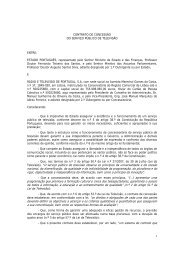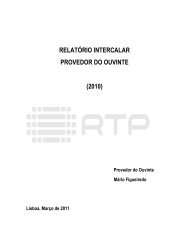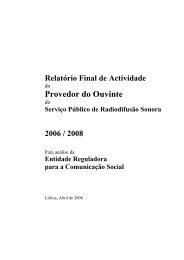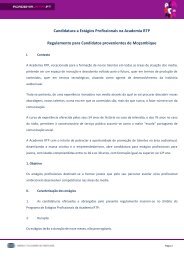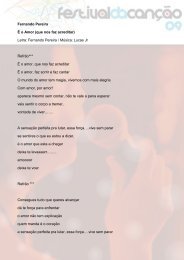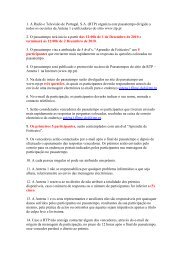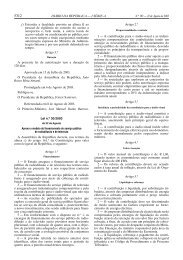land facilities around <strong>the</strong> world: staging bases for aircraft, and processingstations for acoustic and electronic data. Regarding acoustic data, it reliedheavily on its SOSUS networks, often alternatively referred to as Caesar. These,going way back to 1954, involved networks of hydrophonic arrays which sentoceanographic and acoustic data to shore processing facilities, that is, large computeranalysis centers. These data and o<strong>the</strong>rs were correlated at regional processingcenters (including those in Hawaii, Wales, Newfoundland and Iceland) and<strong>the</strong>n forwarded to a main processing center at Moffett Field, California, viaFLTSATCOM and DSCS satellites.52SOSUS, though augmented by o<strong>the</strong>r systems noted below, was <strong>the</strong> backboneof <strong>the</strong> U.S. ASW detection capability. It has been described by SIPRI as follows:Each SOSUS installation consists of an array of hundreds of hydrophoneslaid out on <strong>the</strong> sea floor, or moored at depths most conducive to sound propagation,and connected by submarine cables for transmission of telemetry.In such an array a sound wave arriving from a distant submarine will besuccessively detected by different hydrophones according to <strong>the</strong>ir geometricrelationship to <strong>the</strong> direction from which <strong>the</strong> wave arrives. This direction canbe determined by noting <strong>the</strong> order in which <strong>the</strong> wave is detected at <strong>the</strong> differenthydrophones. In practice <strong>the</strong> sensitivity of <strong>the</strong> array is enhanced manytimes by adding <strong>the</strong> signals from several individual hydrophones after introducingappropriate time delays between <strong>the</strong>m. The result is a listening<strong>Bases</strong> <strong>during</strong> <strong>the</strong> <strong>Cold</strong> <strong>War</strong> 127İ 2007 Robert E. Harkavy“beam” that can be “steered” in various directions towards various sectorsof <strong>the</strong> ocean by varying <strong>the</strong> pattern of time delays. The distance from <strong>the</strong>array to <strong>the</strong> sound source can be calculated by measuring <strong>the</strong> divergence of<strong>the</strong> sound rays within <strong>the</strong> array or by triangulating from adjacent arrays.The first SOSUS systems were completed on <strong>the</strong> continental shelf off <strong>the</strong> eastcoast of <strong>the</strong> U.S. in 1954.53 O<strong>the</strong>rs were later installed off both U.S. shores andat Brawdy, Wales – <strong>the</strong> Pacific Coast system came to be known by <strong>the</strong> codenameof Colossus.54 A jointly operated U.S.–Canadian array came to be centeredat Argentia, Newfoundland, o<strong>the</strong>rs at Hawaii, <strong>the</strong> Bahamas and <strong>the</strong> Azores.55By 1974 it was stated that <strong>the</strong>re were 22 SOSUS installations located along<strong>the</strong> east and west coasts of <strong>the</strong> U.S. and near various chokepoints around <strong>the</strong>world – ano<strong>the</strong>r 14 were identified by Richelson and o<strong>the</strong>rs.56 Foreign-basedSOSUS installations were located at Ascension, in <strong>the</strong> Azores (Santa Maria), <strong>the</strong>Bahamas (Andros Island), Barbados, Bermuda, Canada (Argentia), Denmark,Diego Garcia, Gibraltar, Guam (Ratidian Point), Iceland (Keflavik), Italy, Japan(sonar chains across <strong>the</strong> Tsugaru and Tsushima Straits), Norway, Panama(Galeta), <strong>the</strong> Philippines, <strong>the</strong> Ryukyus, Turkey, <strong>the</strong> U.K. (Scatsa, Shetland andBrawdy, Wales). O<strong>the</strong>rs have at times been operated on Grand Turk Island,Antigua, Bahamas (Eleu<strong>the</strong>ra) and Barbados; and maybe on <strong>the</strong> Canary Islandsat Punta de Tero. And <strong>the</strong> U.S. may possibly also have operated still o<strong>the</strong>rbarrier sonars, for instance, in <strong>the</strong> central Mediterranean from Lampedusa and/orPantelleria Islands, and on Midway Island in <strong>the</strong> central Pacific Ocean.Burrows described as follows <strong>the</strong> basic geometry of <strong>the</strong> U.S. SOSUS networkwhich monitors Soviet egress from <strong>the</strong> Eurasion bastion:There are actually two SOSUS arrays moored across <strong>the</strong> approaches to Polyarnyy;one between Norway and Bear Island, and <strong>the</strong> o<strong>the</strong>r linking nor<strong>the</strong>rnScotland, Iceland, and Greenland. Submarines whose home port isPetropavlovsk are monitored by hydrophones strung from <strong>the</strong> sou<strong>the</strong>astern tipof Hokkaido, along a line parallel to <strong>the</strong> Kuriles, and <strong>the</strong>n up toward <strong>the</strong>nor<strong>the</strong>ast, off <strong>the</strong> Aleutian coast. Still o<strong>the</strong>rs stretch from sou<strong>the</strong>rn Japan to<strong>the</strong> Philippines, covering <strong>the</strong> approaches to China and Indochina. And <strong>the</strong>reare also SOSUS installations on <strong>the</strong> Atlantic side of Gibraltar, o<strong>the</strong>rs abouthalfway between Italy and Corsica and still o<strong>the</strong>rs at <strong>the</strong> mouth of <strong>the</strong>Bosporus, off Diego Garcia in <strong>the</strong> Indian Ocean, and not so far from Hawaii.The Navy keeps <strong>the</strong> precise locations of its SOSUS equipment a closelyguarded secret, since interfering with it would be a logical Soviet subject.57Nuclear detection58One important, but seldom commented upon aspect of <strong>the</strong> overall U.S. intelligenceeffort, was that connected with <strong>the</strong> detection of nuclear explosions. Thisinvolved several separate lines of activity.First, <strong>the</strong>re was <strong>the</strong> matter of verification of existing arms control treaties,128 <strong>Bases</strong> <strong>during</strong> <strong>the</strong> <strong>Cold</strong> <strong>War</strong>İ 2007 Robert E. HarkavyPage 35
that is, <strong>the</strong> Limited Test Ban Treaty of 1963, which bans atmospheric testing,and <strong>the</strong> Threshold Test Ban Treaty of 1974, never ratified by <strong>the</strong> U.S. Senate(but tacitly adhered to in <strong>the</strong> manner of SALT II), which barred undergroundtesting of nuclear devices of over 150 kilotons. Second, <strong>the</strong>re was <strong>the</strong> monitoringof <strong>the</strong> horizontal nuclear proliferation activities of hi<strong>the</strong>rto non-nuclearstates, as well as of <strong>the</strong> non-signatory but nuclear states, China and France.Third <strong>the</strong>re was <strong>the</strong> contingency of protracted nuclear war <strong>during</strong> which <strong>the</strong> U.S.would have wanted to determine <strong>the</strong> locations and frequencies of nuclear detonationson both sides and to assess resultant damage, among o<strong>the</strong>r reasons, toaid subsequent targeting decisions.Several interrelated systems were used to pursue <strong>the</strong> above ends, involvingsatellites, aircraft and ground stations. Use of satellites, in connection withbases, raised <strong>the</strong> question of external facilities for data down-links and commandand control; that of aircraft involved, obviously, bases as well.According to Richelson, <strong>the</strong> U.S. space-based nuclear-detection systeminvolved, variously, <strong>the</strong> various components of <strong>the</strong> VELA satellite program begunin <strong>the</strong> early 1960s, <strong>the</strong> previously mentioned DSP satellites primarily intended forearly warning of missile launches, and <strong>the</strong> NAVSTAR global positioning system.59Numerous aircraft types were used to detect airborne atomic debris left in <strong>the</strong>wake of explosions (if only <strong>the</strong> venting of imperfectly conducted undergroundblasts). One source said that <strong>the</strong>se included <strong>the</strong> U-2, P-3C, C-135, B-52 and alsoan HC-130 configured as a sea-water sampler to monitor underwater nuclear tests(monitoring of plutonion-239 separation via kryption-85 analysis was presumablyalso similarly conducted). For instance, SAC’s U-2s apparently operated out ofAustralian facilities at Sale and Laverton, ga<strong>the</strong>ring radionuclides as part of a HighAltitude Sampling Program. These aircraft were operated by <strong>the</strong> Air Force TechnicalApplication Center (AFTAC) and could presumably have availed <strong>the</strong>mselvesof virtually all <strong>the</strong> airfields normally open to U.S. use throughout <strong>the</strong> world. Someof <strong>the</strong>se operations no doubt involved ad hoc staging through facilities after an“event,” and <strong>the</strong> diplomacy of access involved was obscure. But, as <strong>the</strong>re was ageneral convergence of overall interest by most nations with regard to monitoringo<strong>the</strong>rs’ nuclear tests, access in <strong>the</strong>se cases was likely to have been permissive.The Soviet <strong>Cold</strong> <strong>War</strong> naval basing structure60Before World <strong>War</strong> II, <strong>the</strong> USSR had had only very limited access to externalfacilities, perhaps solely with <strong>the</strong> forward deployment of some combat aircraft inCzechoslovakia in <strong>the</strong> 1930s. In parallel, Moscow was <strong>the</strong>n only a small factorin <strong>the</strong> international arms trade, so it was not able to bank ei<strong>the</strong>r on security assistanceor ideological ties and alliances to establish forward bases. That situationchanged dramatically after World <strong>War</strong> II, with an additional quantum jump in<strong>the</strong> late 1950s and on up to 1970s.Directly after <strong>the</strong> war, of course, Moscow established control over EasternEurope (earlier also in Mongolia), and <strong>the</strong>se dominated areas became <strong>the</strong> sitesfor a massive network of Soviet air, naval and ground facilities, with a heavy<strong>Bases</strong> <strong>during</strong> <strong>the</strong> <strong>Cold</strong> <strong>War</strong> 129İ 2007 Robert E. Harkavyconcentration in East Germany, Poland, Hungary and Czechoslovakia as anobvious correlate to Soviet political control over <strong>the</strong>se countries and as a defensiveglacis or possible springboard for offensive operations vis-à-vis NATOWestern Europe. Again, <strong>the</strong> basis for basing access was simply brute conquestand imperial control.For some ten years after <strong>the</strong> end of <strong>the</strong> <strong>Cold</strong> <strong>War</strong>, <strong>the</strong> USSR had no basingaccess outside of its huge contiguous Eurasian empire. Indeed, it also had virtuallyno arms transfer or security assistance relationships outside this area <strong>during</strong>a period in which <strong>the</strong> U.S. established its elaborate structure of alliances andarms transfer relationships all around <strong>the</strong> Eurasian rimland.That all changed around 1955 with <strong>the</strong> beginning of <strong>the</strong> Soviet weaponstransfers to Egypt and Syria. But <strong>the</strong>n too in <strong>the</strong> late 1950s and early 1960s,numerous nations in <strong>the</strong> wake of decolonization and <strong>the</strong> creation of nominallyMarxist regimes, became Soviet arms client states. Along with that, sometimeswith a time lag, came <strong>the</strong> provision of basing access at a time, also, whenMoscow was beginning to build a “blue-water navy.” And, some of <strong>the</strong> newarms recipients and basing hosts involved a “leapfrogging” of <strong>the</strong> containmentPage 36Page 37
- Page 2 and 3: This provided the U.S. access to a
- Page 4 and 5: ecame a hot issue within Japan, and
- Page 6 and 7: SpainRotaMajor naval base; also air
- Page 8 and 9: eturn to the link here with aircraf
- Page 10 and 11: which were in Fairbanks (Alaska), T
- Page 13: Molesworth), Belgium (Florennes), t
- Page 17 and 18: III,” 14 stations giving flexible
- Page 19 and 20: wire retaliation strike plan. The n
- Page 21 and 22: Ocean surface surveillance47The U.S
- Page 23 and 24: each site, providing variable cover
- Page 25: Pinetree LineCanadaBroughton Island
- Page 29 and 30: Missile Crisis.68At another level,
- Page 31 and 32: Access for Soviet surface ships.Per
- Page 33 and 34: nel in Libya, whose air force compr
- Page 35 and 36: systems (an exception, of course wa
- Page 37 and 38: Madagascar). There was also a signi
- Page 39 and 40: Aden, Bahrain, Malta, Mauritius, Si


